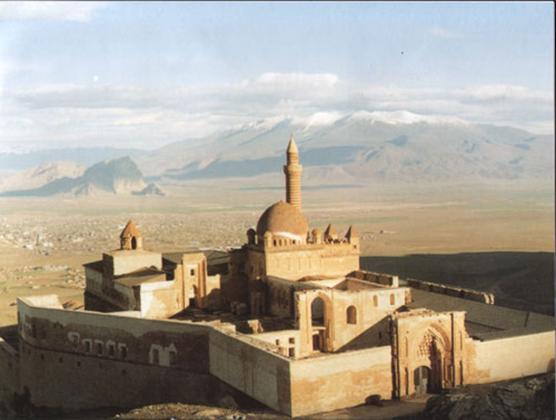HOTEL ORTADOĞU
AĞRI İSHAK PASHA PALACE
 |
İshak Pasha Palace is more of a complex than a mere palace. It is our second administrative campus after the Topkapı Palace in İstanbul and the most famous of the palaces built at recent decades.The palace which was built on a hill at the side of a mountain 5 km. east of Doğubeyazıt District is the last large monumental structure of the Ottoman Empire in the "Lale Devri" Period. It is one of the most distinguished and magnificent examples of the 18th century Ottoman architecture and is very valuable in terms of art history. According to the top of the door inscription at the Harem Section it was constructed in 1784 (1199 H.) according to the Islamic calendar.
As the ground building sits on is a valley slope, it is rocky and hard. Despite the fact that it is at the center of the Old Beyazıt city its three sides (north, west, south) are steep and sloped. There is a suitable flat area only to the east. The entrance of the palace is on that side. It's also its narrowest façade.
As the palace was built in an age when the castles ceased to be special and fire arms were developed and were abundently available its defense towards the hills on the east is weak. Its main gate is the weakest point in that respect. The structure of the main gate is no different than those seen in the palaces built in İstanbul and elsewhere in Anatolia and has a neat stone workmanship and carving.
Today we have very few examples of the historical Turkish palaces still surviving. One of these is the İshak Pasha Palace and complex.
Ishak Pasha Palace is composed of following sections in terms of architectural style:
1- Exterior façades
2- First and second courts
3- The men's quarter (selamlık)
4- The mosque building
5- The Soup Kitchen (Darüzziyafe)
6- Bath
7- Rooms of the Harem Section
8- Hall for ceremonies and entertaintment
9- Arch gates
10- Panteries and ammunition room
11- The mousoleum
12- The bakery
13- Dungeons
14- Some sections from interior design (doors, windows, cupboards, fireplaces, soft drink cupboard etc.)The characteristic of the palace is in its mixture of Ottoman, Persian and Seljuk architectural styles. The palace was built in 1685 by II. İshakpaşa of the Çildıroğulları and Çolak Abdi Pasha and took its final form in 1784. The building occupies an area of approximately 115m. x 50 m. The portal on the eastern façade of the palace, which is built with cut stones, reflects the characteristics of the Seljuk art with its reliefs and decorations.
The palace is composed of two courts and the collection of structures positioned around them. Some of the buildings of the first court are destroyed. The second court which is surrounded on four sides with buildings has a rectangular plan. To the right, with reference to the entrance there is the men's quarter and behind it the harem section. At the end of these, there is the mosque and the mousoleum. The mousoleum is built in the style of the Seljuk "kümbet" (cupola) architecture. The palace section has two storeys. All of its 366 rooms are arranged on these two floors. Each room has a stone fireplace. The cavities within the stone walls indicate that the building as a whole possessed a central heating system.The reception hall is 30m.x3 m. It has stone walls and floor . Its walls are decorated with couplets and verses from the Koran in the decorative examples of the Turkish Calligraphy art. Among these a couplet, which in very free translation goes like "Ishak, upon will, made the whole world a place of benevolence and the date to witness this was one thousand one hundred ninetynine" and indicates that the palace was completed in 1784 A.D. The mousoleum in the second courtyard of the palace is built with cut stones This octaganal mousoleum is in the shape of the copolas, which is one of the most typical examples of the traditional Seljuk mousoleum architecture and has two storeys. Its walls are decorated with geometric motifs. Çolak Abdi Pasha, İshak Pasha and their close kin are resting at this mousoleum.The interior and exterior architectural wealth of the İshak Pasha palace could be described forever. Whether the palace is taken as a whole or should its rooms and buildings studied individually, success, order and mastery is all that one can find
İshak Pasha Palace stands at a desolate valley today and the fact that it was the subject of various legends and stories add to its magnificent atmosphere some colour and mystery.
| ANASAYFA | • | TURKCE | • | ENGLISH | • | ONLINEREZERVASYON | • | FOTOGALERY | • | İLETİŞİMFORMU |
DOĞUBAYAZIT/AĞRI
TURKEY
0090-472-3124225